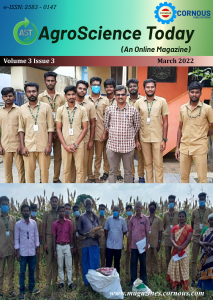Oil seeds production and productivity remains static over period of time in India. Every year major portion of requirement is imported from other countries. The decrease in area under production of oilseeds is in alarming rate. India is the major oil seed producing country (20% in area and 10% in Production). Annual production of oil seeds is 32.0 MT and annual total requirement of oilseeds is 45.64 MT. Hence, to minimize the shortfall in requirements, every year is 10-15 MT of oilseeds is imported. Percapita consumption of oil seeds is 8 Kg/year. Increase of production to 60 MT, will definitely decrease the oilseeds import. Major oil seed crops viz., groundnut, rapeseed, soybean, mustard, sunflower, and sesame Increase in area, production and productivity oilseeds need systematic approaches from policies to technological interventions.
Rice (Oryza sativa L.) is one of the highly sensitive crops to zinc deficiency. Zinc is the most important micronutrient limiting rice growth and yield next to nitrogen and phosphorus. Soil having coarse texture, low organic matter content, high pH and presence of CaCO3 are prone to zinc deficiency. Zinc deficiency usually appears in 2 to 3 weeks after transplanting rice seedlings. It affects tiller production, plants remain stunted and in severe cases complete crop loss may occur. Also it increases the spikelet sterility and time to crop maturity. It can be managed by soil application and foliar spray of zinc fertilizers. Soil application of zinc sulphate through broadcasting and incorporation proved more efficient and economical method for correcting the zinc deficiency.
RAWE – Rural Agricultural Work Experience. This programme imparts quality, practical and production oriented knowledge to all the agricultural graduates by allotting the Village Stay Programme at various districts and studying the practical agricultural work with the farming communities, identifying their problematic situation and transferring the new agricultural technology with the help of various extension tools. RAWE programme makes the agricultural students understand their theoretical part in a practical way and lays a path for understanding the current market situation.
Resistant Starch (RS) are those parts of our ingested food which are not digested by our digestive enzymes and are passed into the intestine where they get fermented. According to their digestive activities against α-amylase, RS can be of five types- RS1 (physically inaccessible), RS2 (native), RS3 (retrograded), RS4 (modified) and RS5 (amylose-lipid complex). Some of them can be digested partially after processing and cooking. RS have various beneficial effects on our digestive system, like maintaining intestinal microbial flora, restricting colon cancer, insulin level, glycemic index, etc. It also acts as a good source of fiber and enhances color and taste of food. Thus, it finds a huge application in processed food industries and healthcare sector for its unique physicochemical characteristics.
Integration of artificial intelligence (AI) with the Internet of Things (IoT) provides a platform for creating truly intelligent, networked devices and applications. The Artificial Intelligence of Things" (AIoT) is working to develop cost-effective, intelligent, and scalable solutions for a more sustainable, interconnected society. In other words, using IoT sensing and AI decision-making skills enable large-scale industrial automation that is self-healing and self-managed. At the same time, AIoT assists enterprises in promoting learning and customization. AIoT synergizes solutions for a successful digital transition by enabling for the addition of more advanced predictive capabilities. AIoT can employ data analytics to make appropriate recommendations or take appropriate actions.
There is a universal fact that every individual plant species in this world will multiple into several new species or copies either through sexual or asexual reproduction. For this sexual reproduction to be taking place, pollination has a pivotal role in each & every flowering plants. The male gametophytes are present in the pollen grains & are produced in the anthers & the female gametophytes are present in the stigma on which the male gametophyte the pollen grains are attached & thus pollination takes places in flowering plants. Homozygosity of crop species can be increased by autogamy. Autogamy leads to heterosis but do not show inbreeding depression. Allogamy shows considerable amount of heterosis & show mild to severe inbreeding depression. They are highly heterozygous. Considering the tremendously increasing population, the world can’t be survived if there is no pollination in the flowering plants. This makes us to realize,” how much precious is the pollination is”.
A street food is characterized by ready to eat foods which is sold by vendors or local people located in street or road side or city. It is one of the fast moving foods consumed by busiest population. Even though street foods are good in taste, flavor, texture and ready to take away, the vulnerability of these foods is very dangerous. Street foods are associated with harmful microorganisms. This article elaborated penetrating glance of street foods and its associated harmful microorganisms.
Permaculture is the type of farming in eco-friendly manner which comprises of diversity of plants which can withstand climatic changes, agroforestry, silviculture, agropastoral system, water harvesting including micro-catchment area, aquaculture, sustainable and zero budget farming and livestock rearing. Resource recycling is the common process in permaculture. The yield is more in permaculture than conventional farming as it focuses not only in yield of main crops but also on yield of by-products because in permaculture wastes produced were used in efficient way. When compared to conventional farming, permaculture produces 35 times the amount of food per square meter than conventional farming with less usage of resources which is less than 20%. It aims at curtailing dependence on inputs for cultivation.
